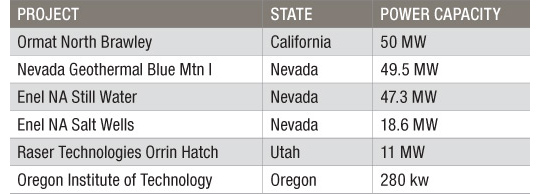Geothermal startups and university grants funded by Google.org

The United States -- especially California -- gets a substantial amount of non-hydro renewable energy from geothermal. We've reported on new geothermal technologies in this EPRI article and recently summarized last year's geothermal action.
In fact, while solar and wind get all the headlines, geothermal quietly produced 4.5 percent of California’s total system power in 2007, with more than 40 operating geothermal plants in the state. Most U.S. geothermal installed capacity remains concentrated in California; in 2005, California’s geothermal power capacity was more than that of every country in the world, according to the GEA.
Charles Baron, Google's geothermal program lead, spoke in San Francisco at this week's GeoPower Americas 2010 gathering. Baron is a geothermal enthusiast, as is Google.
As testament to its earnestness about geothermal, Google has invested in geothermal start-ups Altarock Energy and Potter Drilling. Google has also invested in a number of other renewable energy firms, including solar firms BrightSource Energy and eSolar and high-altitude wind innovator Makani Power.
Google has issued geothermal grants, as well.
Google issued a grant to Southern Methodist University's geothermal lab for geothermal resource mapping, in what seems an obvious synergy with Google Earth. Much of today's geothermal data mapping is based on data collected in the 1970s. Since then, millions of geothermal data points have been collected from oil, gas and geothermal exploration but have not been aggregated and analyzed. The grant supports SMU in aggregating data for the most under-sampled regions of the U.S. and in developing new methodologies for estimating geothermal resources, according to Google's Baron.
Stanford University also received a geothermal-focused grant from Google to investigate single-well systems.
On the global side, the technical community faces a formidable challenge when it comes to developing ways "to speak apples to apples about geothermal" measurements across different regions. It will be important to come up with a common language to communicate about global geothermal resources, according to Baron.
Baron also posed the question, is geothermal interesting to VCs?
The answer is somewhat nuanced. If geothermal is going to be a good fit for the venture capital asset class, investments will have to be in technology that is, "extremely disruptive," requiring significant "technology whitespace."
While Flash and Organic Rankine Cycle (ORC) geothermal are mature technologies and don't have much technical headroom, EGS (Enhanced Geothermal) and geo-pressurized technology are nascent and have the potential to be disruptive. Enhanced Geothermal Systems do not rely on naturally occurring reservoirs of hot water. Instead, EGS technology attempts to create geothermal resources by pumping high-pressure cold water into injection wells and then harvesting the heated water.
Baron also cited a number of studies that highlight geothermal's strong points:
- Most cost-effective renewable energy source (NYU study)
- Least land-intensive renewable (Northwestern University - Nature Conservancy study)
- Cheapest generation option (Gigaton Throwdown)
Here's your Google geothermal-search fun fact of the day: Google searches for "geothermal" occur more in the winter and, on a normalized basis, Iowa is the leader in searches for "geothermal." (Baron was at a loss to explain the significance of that little tibdit, as was the audience.)
The recent focus on geothermal -- and the serious dollars being channeled towards this technology -- signals an important new shift for venture capital and the DOE.
P.S.: I promised you some U2 action -- arena band U2 are raising modest funding to help pay for Turkey's Dora-1 geothermal facility.
Some Geothermal Stats (GEA)

Geothermal Map of North America
The total online capacity of geothermal power in the U.S. was 3,152 megawatts as of August 2009, with about 2,600 megawatts in California and 448 megawatts in Nevada. Those two states will continue to dominate the geothermal landscape for the foreseeable future.
Six new geothermal plants came online in the U.S. in 2009 and more than 100 are under development. That's a potential of 10 gigawatts of geothermal power coming online in the next decade. Here is a list of the six most recent projects:
In 2009, as part of the ARRA stimulus, $400 million was appropriated for the DOE Geothermal Technologies Program, with over 100 geothermal projects in 39 states. Recipients include private firms, academia, local governments and National Labs.
In 2009, The DOE invested more than $5 million into a demo project for the Enhanced Geothermal Systems plant operated by Ormat at Desert Peak, Nevada. The DOE has also selected other EGS projects for federal funding.
Geothermal industry players: Ormat is considered the leading pure-play geothermal firm. Competitors include U.S. Geothermal, Nevada Geothermal Power, Polaris Geothermal, Geothermal Resources, Calpine and Chevron Texaco.
Outlook for Geothermal in the Next Decade
- Geothermal will become more visible and accepted as a baseload power source.
- Carbon and climate change legislation will exert pressure for geothermal policy support by federal and state politicians.
- More private equity will flow into this space.
- Ambitious state Renewable Portfolio Standards in Nevada and California will continue the flood of projects in those states. The number of states with active geothermal power will increase to include Arizona, Alaska, Idaho, Hawaii, Wyoming, New Mexico, Louisiana, Mississippi, Oregon, and Utah.
- New technology will improve the efficiency and power potential of geothermal resources.
Aucun commentaire:
Enregistrer un commentaire